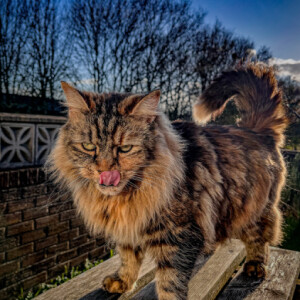A young male lion, his mane not yet fully grown, follows a dry riverbed. His attention is caught by a scent carried on the wind from a patch of scrub. Curious, he climbs the bank and buries his nose deep in the vegetation. When he lifts his head again, his jaws are wide open and his cheeks are pulled upwards, his eyes half closed. He licks his nose repeatedly, as if tasting the air. Then, with a final sniff of the bushes, he saunters off.
To see this fascinating behaviour – usually known by its German name, flehmen you don’t need to travel to the African savannah. You’re just as likely to spot it if you watch a pet moggy prowling the urban jungle. In fact flehmen is performed by all 37 species in the family Felidaefrom lions and other big cats to the black-footed cat, the world’s smallest wild feline (adults weigh just 1–2.45kg).
Cats carry out this ritual only when they’ve just sniffed a scent mark left by another cat. The facial contortions cause odour to be sucked up from the mouth into the sensory part of the one sense organ that cats possess but primates, like ourselves, do not – the vomeronasal, or Jacobson’s, organ. This lies between the nostrils and the roof of the mouth, and is connected to both via ducts called the nasopalatine canals. If a cat wishes to bring its vomeronasal organ into play, it has to twist its face into a grimace.


Comments
Sign in or get an account to comment.


